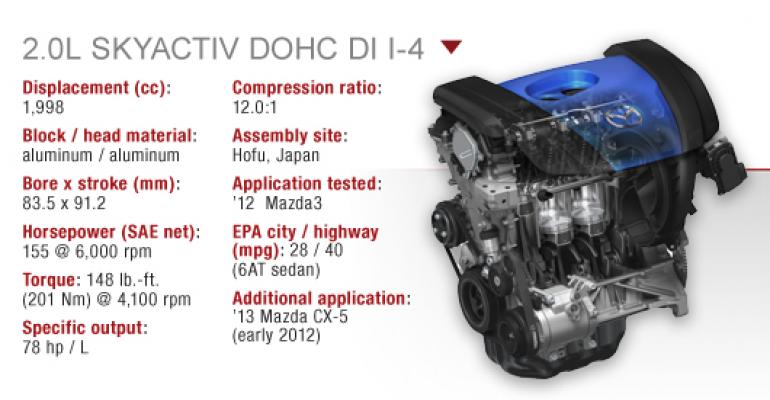Occasionally, without any planning or foresight, the stars align perfectly and engines that are direct rivals happen to arrive in our office at exactly the same time, allowing easy comparisons as editors cycle through the Ward’s 10 Best Engines vehicles.
Such was the case with three excellent all-new naturally aspirated 4-cyl. engines in the Ford Focus, Hyundai Elantra and Mazda3. For more than a week in early November, editors compared and contrasted the engines in these three vehicles, then debated their merits around the water cooler.
In the end, the Mazda3 stands taller than the others with a free-revving vigor directly attributable to its best-in-class torque peak of 148 lb.-ft. (201 Nm) at a reasonable 4,100 rpm.
That extra oomph is noticeable when pulling away from stop lights and passing on the highway.
Despite repeated thrashing by WardsAuto editors over the course of a 750-mile (1,207-km) evaluation, the Mazda3’s DI 2.0L gleefully responds with fuel-economy numbers that top 34 mpg (6.9 L/100 km).
Its fuel-sipping prowess owes much to an unusually high compression ratio of 12.0:1, which demonstrates an exemplary level of thermal efficiency.
A high compression ratio also creates other challenges, such as engine knocking, which Mazda engineers addressed by reducing combustion duration – an approach that shortens the time the unburned air-fuel mixture is exposed to high temperatures. With this strategy, normal combustion ends before knocking occurs.
This is no run-of-the-mill 4-banger. Instead, it springs from Mazda’s new Skyactiv suite of technologies, designed to eliminate weight and friction and deliver more power and better efficiency in a holistic approach that encompasses chassis, transmission, steering and engine technologies.
Go ahead and poke fun at the name, but Skyactiv works well in the case of the new Mazda3. A marketing campaign cleverly admits the Mazda3 is not the first compact car available with a 40-mpg (5.9 L/100 km) highway rating, but it’s the first one worth driving.
That might be a little unfair to the competition, especially when the only engine to see 40 mpg in our admittedly lead-footed testing was the VW Passat diesel.
But perhaps Mazda managers can’t contain their excitement about future iterations of the Skyactiv 2.0L. A turbocharged variant, eagerly awaited, seems a sure bet.
But before that, the naturally aspirated 2.0L will find a new home in the CX-5 compact cross/utility vehicle, arriving in early 2012.
And that version, because of its deeper engine bay, will allow for an innovative new “4-2-1” exhaust manifold that lowers combustion temperatures by preventing exhaust gases from returning to the combustion chambers.
The end result in the case of the CX-5 is an even higher compression ratio of 13.0:1, and Mazda engineers say a 14.0:1 compression ratio is possible in the future.
This is the type of innovation that sets up Mazda to deliver consistently excellent powertrains.



